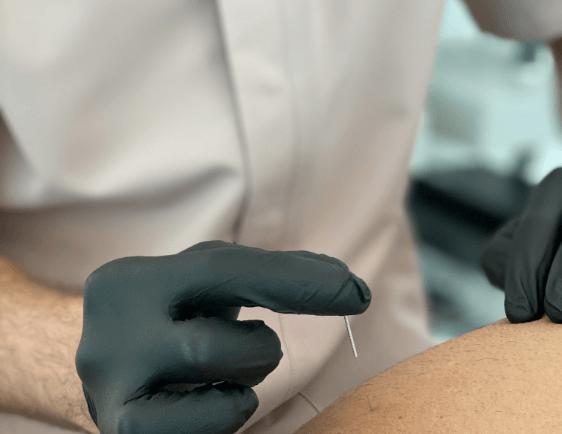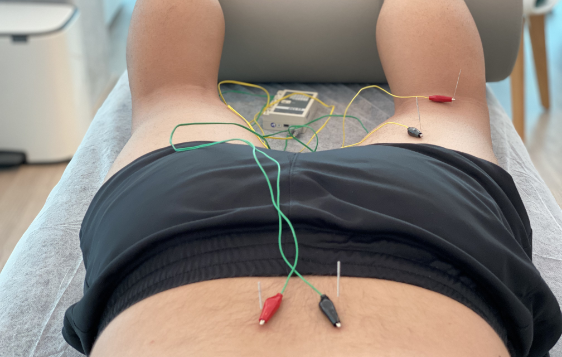
Dry needling
Dry needling is an invasive technique aimed at deactivating muscle or myofascial trigger points in order to reset and relax the target muscle.
What is a trigger point?
A trigger point is a palpable nodule or hyper-irritable spot within a taut band of muscle (a group of fibers within the muscle holding greater tension than the rest), which, upon compression, generates pain and triggers a map of referred pain, that is, a characteristic and specific non-local pain for each trigger point. If it is an active trigger point, when pressed, the patient will associate it with his referred pain.
This technique consists of the introduction of a sterile needle into the muscle until it reaches the trigger point and stimulates the motor plate and neuromuscular spindle, immediately reducing the pain felt by the patient and producing a reflex muscular relaxation and increased elasticity. It is known as “dry” because no type of substance is injected while the technique is performed.
This technique can be performed in one of two ways: superficially (without reaching the trigger point), or deep (the needle passes through the trigger point).
Does it cause discomfort?
This technique can be uncomfortable when applied, and localized discomfort may be felt for 24-48 hours (similar to the stiffness felt after intense activity). However, it is a good treatment option to consider due to the manner in which it efficiently provides rapid pain relief, which means it works better in conjunction with other active and passive treatment techniques.
In some cases, its application requires the use of an ultrasound machine to guide us and perform it safely, especially when it is applied to hard-to-reach muscles or where there is some risk of puncturing an important and delicate anatomical structure, such as major blood vessels (arteries, veins), nerves, viscera, or lymph nodes.
Because of these types of problems, and because it is an invasive technique to which not everyone is accustomed, the physiotherapist shall explain the entire process thoroughly before using the technique and shall provide the patient with information regarding advantages and disadvantages, as well as information regarding other treatment alternatives.

Percutaneous neuromodulation
Ultrasound-guided percutaneous neuromodulation technique is defined as the use of an ultrasound-guided needle to produce electrical stimulation of a peripheral nerve at a point along its path or of a muscle at a motor point, with a therapeutic objective.
That is, we use a puncture needle associated with a low or medium frequency electrical current to induce a sensory and/or motor response by stimulating the peripheral nerve.
A technique which, in short, allows us to stimulate the peripheral nerve very precisely at the root level and along its path
In the interest of safety and effectiveness, this technique must be applied while using ultrasound. The professional performing ultrasound-guided physiotherapy must be highly-knowledgeable of human anatomy.
The application is based on stimulation using a puncture needle associated with a low or medium frequency electrical current, in order to induce a sensory and/or motor response by stimulating the peripheral nerve, or to achieve a motor response by stimulating the motor point.
We should remind you that neuromodulation is a safe, effective technique that is practically painless. Percutaneous neuromodulation is one of the most requested techniques among our patients.
Because this therapy offers a shorter recovery time and better prognosis, it has earned a place for itself among workers and athletes who practice diverse sports, for whom this type of therapy can positively impact the treatment of their injuries and even improve their athletic performance. Next, we present a series of indications and contraindications associated with the application of this technique.

INDICATIONS:
- Shorten recovery times.
- Adapt the body to training, Avoid injury risk factors.
- Assess the situation.
- Prevent injuries and future problems.
- Improve the quality of sports life, Optimize the sports performance of the athlete.
CONTRAINDICATIONS:
- Fear of needles
- Clotting problems
- Areas with wounds or scars, tattoos, spots, skin lesions
- Allergies to metals (such as nickel; although there are needles made of a number of different materials, an evaluation must be made and taken into account)
- In pregnant women (in areas close to the pelvic and abdominal regions)
Percutaneous Electrolysis Therapy (EPTE)
Percutaneous electrolysis therapy (EPTE) is a revolutionary technique used to treat tendinopathies. It uses galvanic micro-currents so that the application is practically painless for the patient. This technique is quite effective: application is quick and patient recovery times are greatly reduced.
Therapeutic percutaneous electrolysis is an invasive technique that consists of the application of galvanic micro-currents via an acupuncture needle and guided using ultrasound for maximum precision and facilitated access to the injured area of the tendon. The objective is to induce a physical reaction in the tendon, provoking the controlled inflammation necessary to stimulate and activate the body’s self-recovery mechanisms, which by themselves have not been able to regenerate tendon fibers.
In short, it is a technique in which a micro-current is applied via a needle in order to activate the regeneration processes in the injured tissue. Indicated for all types of patients, EPTE is ideal for elite athletes, but also for other patients who come in with tendon problems.
Frequently Asked Questions about Echoguided Invasive Physiotherapy
What is ultrasound-guided invasive physiotherapy and how does it work?
Ultrasound-guided invasive physiotherapy is a specialised branch of physiotherapy that employs minimally invasive techniques to treat pain and improve muscular and joint functionality. Unlike conventional physiotherapy, it uses fine needles guided by ultrasound to precisely target the affected tissues.
The use of ultrasound allows the physiotherapist to accurately locate specific treatment points, such as damaged muscles or tendons, improving the effectiveness and safety of the procedure. This approach is particularly beneficial for treating deep or chronic injuries where other physiotherapy techniques may not achieve the same results.
What are the benefits of ultrasound-guided invasive physiotherapy for muscular and joint pain?
Ultrasound-guided invasive physiotherapy offers significant benefits in treating muscular and joint pain. Key advantages include rapid pain relief, improved mobility of the affected areas, and accelerated recovery from injuries.
By acting directly on specific points of pain or inflammation, this technique enables precise intervention that helps reduce inflammation and restore muscular or joint function. It is particularly effective for treating chronic and acute injuries, especially in cases where conventional physiotherapy has not been sufficient.
What is the difference between dry needling and other invasive physiotherapy techniques?
Dry needling is one of the most common techniques in invasive physiotherapy, but there are notable differences compared to other methods such as percutaneous neuromodulation or percutaneous electrolysis therapy (EPTE).
Dry needling focuses on deactivating trigger points in muscles, which are knots or tight bands that cause pain and limit mobility. Percutaneous neuromodulation, on the other hand, involves electrical stimulation of nerves to reduce pain and improve muscle function.
EPTE is specifically used to treat chronic tendinopathies by applying a galvanic current to promote the regeneration of damaged tissue. Each technique has its specific indications and is selected based on the type of injury and treatment goals.
Is ultrasound-guided invasive physiotherapy painful?
Ultrasound-guided invasive physiotherapy can cause some discomfort, particularly during needle insertion or when they reach the precise treatment point.
However, this discomfort is usually minimal and temporary, and many patients find that the subsequent pain relief outweighs any initial discomfort.
The use of ultrasound allows the physiotherapist to work with precision, minimising potential discomfort and avoiding sensitive structures. After treatment, it is common to experience a mild sensation similar to muscle soreness, which typically subsides within a few hours or days.
How many sessions of ultrasound-guided invasive physiotherapy are needed?
The number of sessions required varies depending on the type and severity of the injury, as well as how each individual responds to treatment.
In general, patients often notice significant improvement after the first few sessions, though complete treatment may require 4 to 8 sessions.
Chronic or more complex injuries may need additional sessions, while less severe issues can resolve in fewer visits. The physiotherapist will assess your specific case and recommend the appropriate number of sessions to achieve the best results.
Who should avoid ultrasound-guided invasive physiotherapy?
Although ultrasound-guided invasive physiotherapy is safe, it is not suitable for everyone. It should be avoided in patients with bleeding disorders, allergies to materials used, or active infections in the treatment area.
People with implanted electronic devices, such as pacemakers, should consult their doctor before undergoing this treatment.
Additionally, it is not recommended for pregnant women in certain areas of the body, or for individuals with a fear of needles. It is essential that the physiotherapist conducts a thorough evaluation to determine if this treatment is appropriate for each case.
What types of injuries can be treated with ultrasound-guided invasive physiotherapy?
Ultrasound-guided invasive physiotherapy is effective for a wide range of musculoskeletal injuries. Commonly treated conditions include tendinopathies, such as Achilles tendon or rotator cuff injuries, ligament and muscle injuries, and contractures or trigger points.
It is also useful for joint problems and chronic pain in areas such as the back, neck, and limbs. Additionally, this technique is ideal for sports injuries as it enables quicker and more targeted recovery, helping athletes return to activity in less time.
